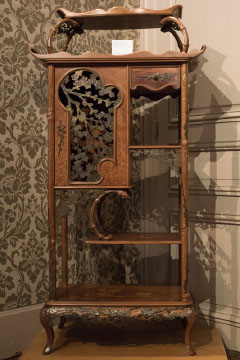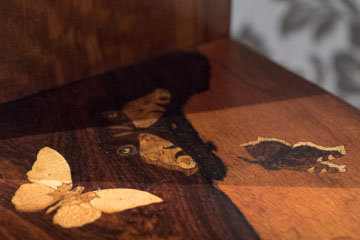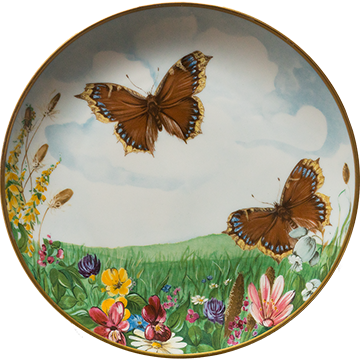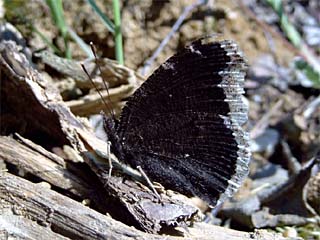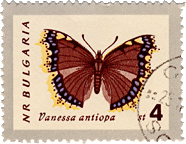One art form with a strong focus on nature is Art Nouveau, which spread internationally from around 1890.
Motifs from flora and fauna were incorporated into the ornamentation and found their way into pictorial art, handicrafts, furniture art and architecture.
Although the heyday of Art Nouveau only lasted 20 years in total, in  Germany
Germany Germany only about a decade, Art Nouveau is still popular and present in many cities and households.
Germany only about a decade, Art Nouveau is still popular and present in many cities and households.
In Musée de l'École de Nancy a piece of furniture by Émile Gallé (1864-1904)Émile Gallé bears the  Camberwell BeautyNymphalis antiopa (Linnaeus, 1758)Mourning CloakCamberwell Beauty as an inlay. Émile Gallé (1864-1904)Émile Gallé is one of the most famous representatives of French Art Nouveau.
Camberwell BeautyNymphalis antiopa (Linnaeus, 1758)Mourning CloakCamberwell Beauty as an inlay. Émile Gallé (1864-1904)Émile Gallé is one of the most famous representatives of French Art Nouveau.
Furniture (Étagè Bambou) with Camberwell Beauty (Nymphalis antiopa) inlay by Émile Gallé around 1894, Musée de l'École de Nancy
Camberwell Beauty (Nymphalis antiopa)-Intarsia on furniture (Étagè Bambou) by Émile Gallé around 1894, Musée de l'École de Nancy
Another protagonist of Art Nouveau, the Scottish artist and architect Charles Rennie Mackintosh (1868–1928)Charles Rennie Mackintosh, had his very own way of combining strict geometry with naturalistic elements.
Anyone visiting The Hill House, the former home of Charles Rennie Mackintosh (1868–1928)Charles Rennie Mackintosh near Glasgow, should take a look at the pattern of the carpet laid there:
The four steps to The Hall are bordered on the right and left by a light-coloured seam with blue spots...
Images of the  Camberwell BeautyNymphalis antiopa (Linnaeus, 1758)Mourning CloakCamberwell Beauty can be found on various items of clothing, umbrellas, bed covers, tablecloths, plates, cups, coasters, lampshades, curtains and much more.
Camberwell BeautyNymphalis antiopa (Linnaeus, 1758)Mourning CloakCamberwell Beauty can be found on various items of clothing, umbrellas, bed covers, tablecloths, plates, cups, coasters, lampshades, curtains and much more.
abinet/shelf with a row of blue spots on a dark background
I found this little cupboard/shelf in the shop window of Butter Küchenstudio + Möbelwerkstätten in Bonn-Lengsdorf.
Camberwell Beauty (Nymphalis antiopa) image on the façade of a Berlin apartment block
The façade of this house in Berlin-Weißensee is adorned with pictures of the Camberwell Beauty (Nymphalis antiopa) as well as other butterfly pictures.
The  Camberwell BeautyNymphalis antiopa (Linnaeus, 1758)Mourning CloakCamberwell Beauty is also a popular motif for wall plates, such as the plate designed by Doris HofmannDoris Hofmann from Kaiser.
Camberwell BeautyNymphalis antiopa (Linnaeus, 1758)Mourning CloakCamberwell Beauty is also a popular motif for wall plates, such as the plate designed by Doris HofmannDoris Hofmann from Kaiser.
Wall plate Kaiser, W. Germany, Camberwelle Beauty, Nymphalis antiopa, Doris Hofmann, ca. 1980
Camberwell Beauty (Nymphalis antiopa), Scarce Swallowtail (Iphiclides podalirius) and a moth as kites
The kite maker Carsten DomannCarsten Domann designs his own models and has visualised the  Camberwell BeautyNymphalis antiopa (Linnaeus, 1758)Mourning CloakCamberwell Beauty as a kite. With a wingspan of 3.5 metres, the kite flies well in light winds.
Camberwell BeautyNymphalis antiopa (Linnaeus, 1758)Mourning CloakCamberwell Beauty as a kite. With a wingspan of 3.5 metres, the kite flies well in light winds.
The  Camberwell BeautyNymphalis antiopa (Linnaeus, 1758)Mourning CloakCamberwell Beauty is the title giver and subject of a great deal of fictional and scientific literature.
Camberwell BeautyNymphalis antiopa (Linnaeus, 1758)Mourning CloakCamberwell Beauty is the title giver and subject of a great deal of fictional and scientific literature.
A selection of German and English-language works:
See also References.
An  Camberwell BeautyNymphalis antiopa (Linnaeus, 1758)Mourning CloakCamberwell Beauty is the protagonist in the book The Last Death of Gautama Buddha, written in 1913 by the committed Buddhist Fritz Mauthner (1849-1923)Fritz Mauthner.
Camberwell BeautyNymphalis antiopa (Linnaeus, 1758)Mourning CloakCamberwell Beauty is the protagonist in the book The Last Death of Gautama Buddha, written in 1913 by the committed Buddhist Fritz Mauthner (1849-1923)Fritz Mauthner.
Excerpt from the final chapter The Butterfly Prediction of the story devised by Fritz Mauthner (1849-1923)Fritz Mauthner:
That's what I heard.
A mantle of the gods, the dark sulphur-fringed butterfly that they call the mourning mantle in the Occident, fluttered from the mouth of the extinct Buddha to the high mountains where the gods dwell. The mantle of the gods carried the soul of the Buddha in its delicate body. This soul had not yet been released.
 Camberwell BeautyNymphalis antiopa (Linnaeus, 1758)Mourning CloakCamberwell Beauty
Camberwell BeautyNymphalis antiopa (Linnaeus, 1758)Mourning CloakCamberwell Beauty
Hibernated Camberwell Beauty (Nymphalis antiopa)
In the further course of the story Fritz Mauthner (1849-1923)Fritz Mauthner the outstanding liberations of Gautama from Remembrance und Mankind, which ultimately lead to the redemption of the soul. The thirty-three gods - Buddhas of the past - are supposed to help Gautama.
Gautama is liberated from humanity by attending his own seven-day funeral from the clouds. During the celebrations, the mourners get into a bitter dispute over the remains of the cremated Buddha. Ananada, the Buddha's favourite disciple, finally calms the disputants and distributes the Buddha's remains fairly among the claimants. Later, a young man accused of treason is stoned to death at Ananada's request.
This brings joy to the watching gods, but Gautama is pained by this act and also by the reaction of the gods. So he resists the desire for divinity and, freed from humanity and memory, passes over into nothingness.
The  Camberwell BeautyNymphalis antiopa (Linnaeus, 1758)Mourning CloakCamberwell Beauty is the motif of many stamps from different countries.
Camberwell BeautyNymphalis antiopa (Linnaeus, 1758)Mourning CloakCamberwell Beauty is the motif of many stamps from different countries.
A selection of stamps with the  Camberwell BeautyNymphalis antiopa (Linnaeus, 1758)Mourning CloakCamberwell Beauty as a motif:
Camberwell BeautyNymphalis antiopa (Linnaeus, 1758)Mourning CloakCamberwell Beauty as a motif:




